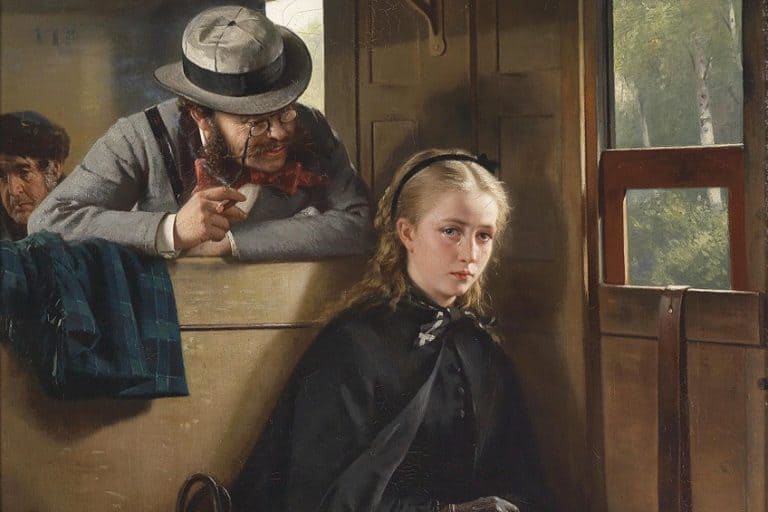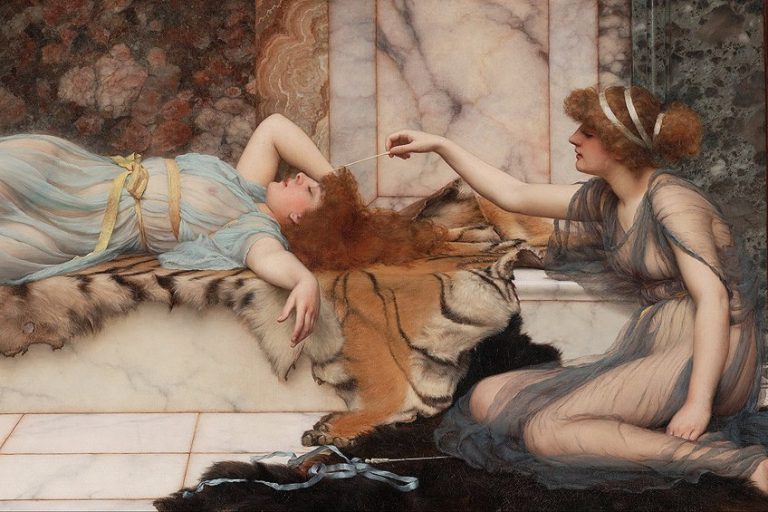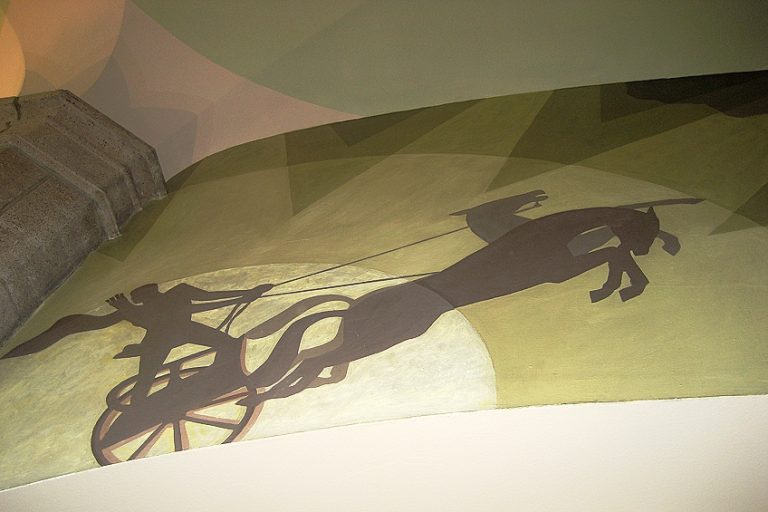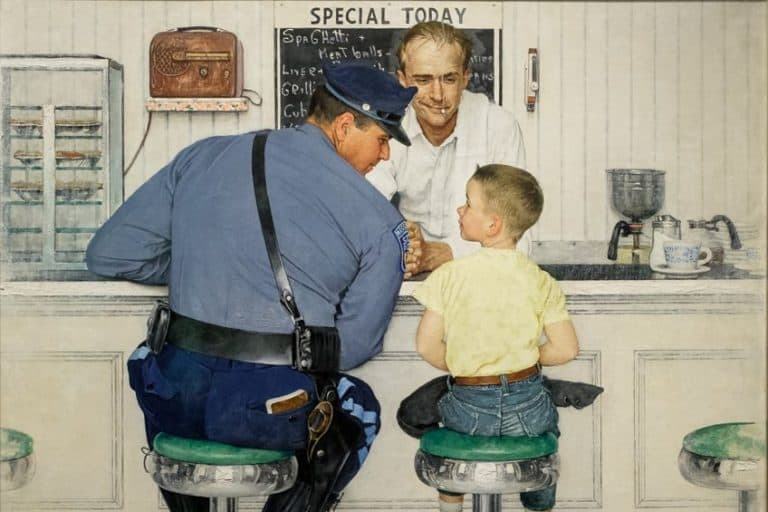Famous Paintings of Hell – Infernal Depictions of the Afterlife
“Abandon every hope, all ye who enter here” – a quote from one of the most influential pieces of Italian literature, La divina commedia (presently known as the Divine Comedy: Inferno), penned by famous Tuscan poet Dante Alighieri (c. 1308-1321), served as a crucial touchstone for many artists and philosophical thinkers of the Renaissance within the context of European art history. The following works of art will lead you through 10 of the most famous depictions of hell as situated within the Renaissance.
La Divina Commedia: Dante’s Inferno and Renaissance Art
There are many viewpoints on what hell looks like and yours may sound something along the lines of a seven-headed beast, a fiery pit of hellfire, souls being tortured in the underworld, and even perhaps your own personal room where you are forced to face your deepest darkest fears… Sounds like hell, does it not? Throughout human history, it has become almost second nature to attempt to ascribe meaning and define the core tenets of human existence encompassing life, death, tragedy, and unfathomable other-worldly occurrences.
Since the dawn of time, humans have faced challenges to survival and as a result, have had to embrace the precarious questions that accompany such situations.
Early depictions of the human condition and suffering can be found in Christian theology, iconography, and philosophy of the early 14th century. Dante’s Divine Comedy is a poem that describes the journey that Dante faces through the nine circles of hell. The poem was written during a period of political unrest in Italy, and outlined, in great detail, Dante’s encounter with the nine circles of hell – with each encounter displaying increasing levels of suffering. At the time, philosophy and insights into the spiritual realm and its influence on mankind played a key role in the livelihoods of many artists, poets, and creative individuals.
Dante’s poem no doubt had a massive impact on Impressionism to follow, surrounding the artist’s interpretation of hell as per religious narratives and the immediate personal hell faced by artists during the revolt against the academy and its traditions.

Famous Depictions of Hell in Art
The Divine Comedy sparked a turn toward multi-faceted depictions of hell in art and its many associations with the divine, fear, existential philosophy, religion, and a shift in art’s historical narrative throughout the Renaissance. The following paintings showcase significant artists who have not only displayed a refined, dynamic sense of craftmanship in interpreting and creating hell artwork, but have also been established as masters, to a degree, of depictions of hell in art, as founded on evolving belief patterns outlined by religious narratives.
The Last Judgement (1306) by Giotto di Bondone
| Artist | Giotto di Bondone (1266/67–1337) |
| Date Painted | 1306 |
| Medium | Fresco |
| Dimensions (cm) | 999.9 x 839.9 |
| Where It Is housed | Cappella Scrovegni, Padua, Italy |
Based in Padua, Italy, the Scrovegni Chapel is home to many exquisitely executed frescos by none other than Giotto di Bondone, one of Western art history’s greatest painters. Modernly dubbed Giudizio Universale, The Last Judgement forms part of a cycle of frescos painted as part of a major project undertaken by Giotto and his assistants at the turn of the Italian Renaissance to capture the artist’s highly regarded skill in the equally revered architecture of the Scrovegni Chapel, which is now a UNESCO cultural heritage site.

Primary attention is drawn to the main subject, Jesus Christ, who is central to the judgment process taking place, as in many other religious paintings depicting divine judgment. Christ is surrounded by angels blowing trumpets, signaling the arrival of the second coming of Christ, and is encapsulated in a divine multi-colored halo or heavenly portal where he is seen placing one foot forward such that he appears to be stepping out to cast his judgment.
The fresco is divided into two distinct sections to showcase the contrast between two worlds – judgment on the side of Christ and judgment into hell.
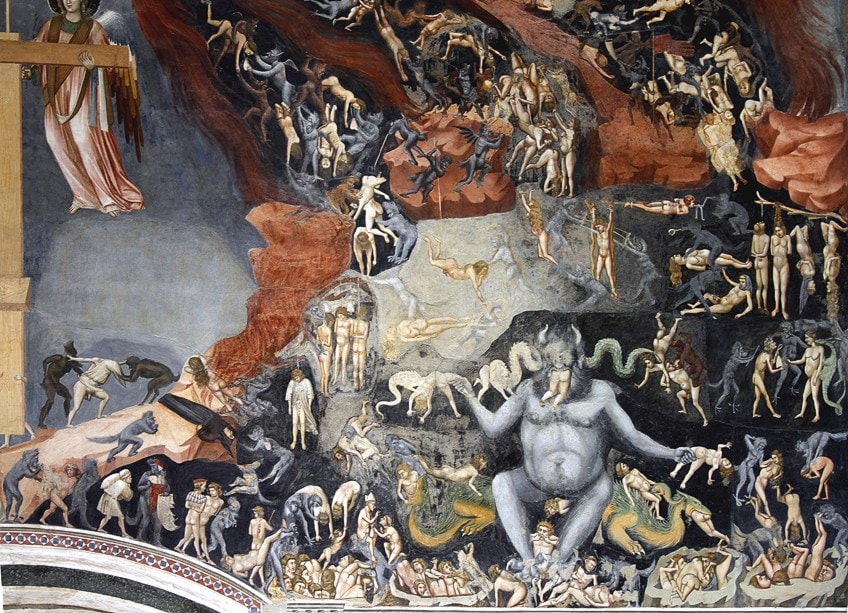
To the bottom right of the painting, those who received punishment and entry into hell are depicted as being forcefully dragged into rocky ruins of cool-toned stone colors – completely devoid of life. The punishment of hell in Giotto’s case involves a series of torture mechanisms; demonic entities and dragon-like creatures inflicting physical harm and devouring the souls of those who did not follow in Christ’s footsteps.
One sees bodies strewn and hung together, bodies hanging off branches, and, as if out of a nightmare, a horned beast with clawed feet, feasting on a damned soul while firmly dangling around two human souls, supposedly next in line.
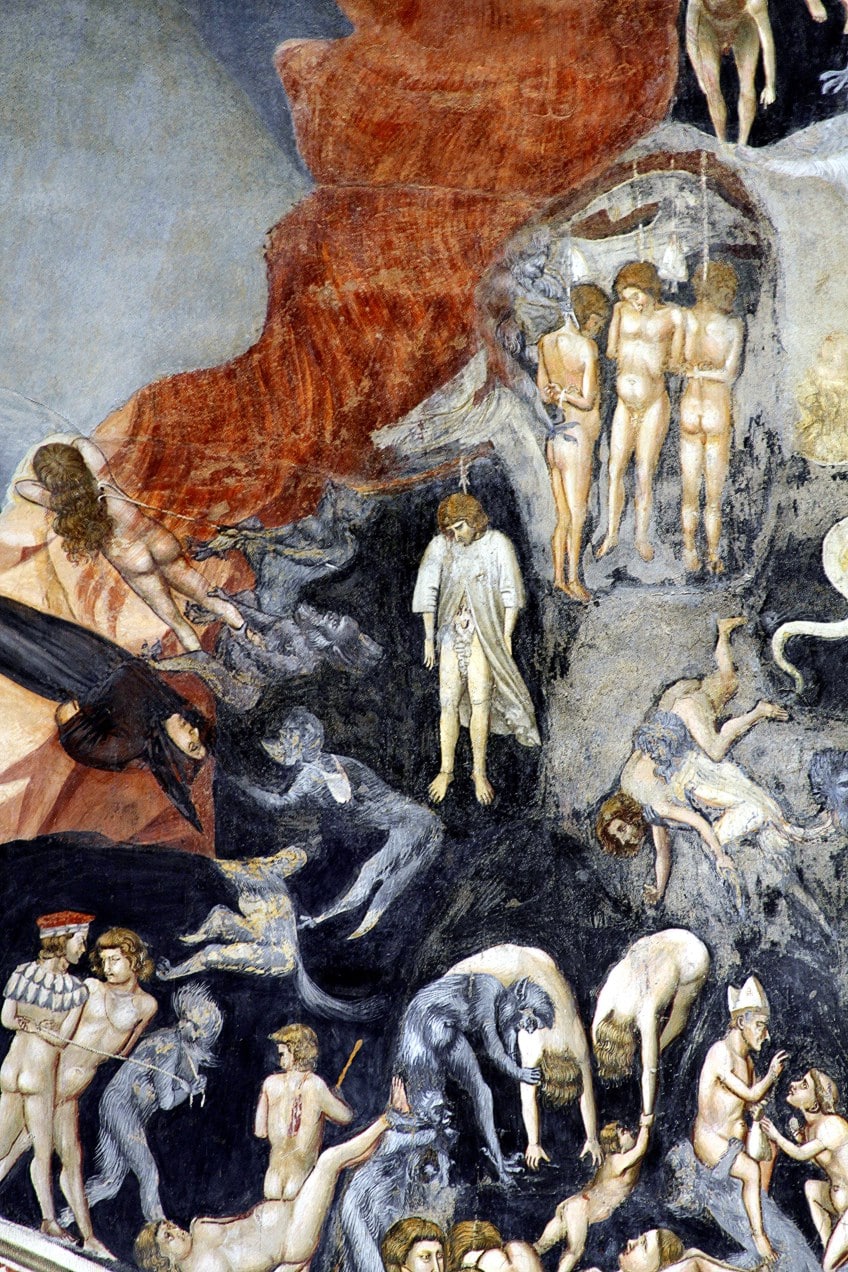
The importance of this depiction of hell is placed on evoking the fear that is associated with hell and the idea of remaining conscious while facing persecution from unholy creatures with devilish smirks. Giotto cleverly illustrates most of the figures in hell to be conscious – clearly alive to witness their own suffering and the suffering of their fellow sinners.
There is no clear structure given to hell as seen contrasted next to the depiction of holiness and “goodness” as seen through saintly robed individuals, intelligently highlighted by the pious nature of their hands and calm demeanor in acceptance of Christ.
The Last Judgement (1431) by Angelico Giovanni da Fiesole
| Artist | Angelico Giovanni da Fiesole (1395/1400–1455) |
| Date Painted | 1431 |
| Medium | Tempera on panel |
| Dimensions (cm) | 104.9 x 210 |
| Where It Is housed | Museo di San Marco, Florence, Italy |
To encounter hell, one must be judged. To become a highly influential painter and stand out among the crowd, one must look to the old masters. Our journey through seemingly terrifying art follows another classical piece by Tuscan artist, Angelico Giovanni da Fiesole, posthumously known as Fra Giovanni. While Michelangelo includes the depiction of naked figures, Fra Giovanni paints a clearer image of the stark differences between those receiving judgment towards heaven and those receiving damnation into hell, as depicted in the bottom right-hand corner of The Last Judgement (1431).

All the figures following Christ seem to be clothed and almost at peace with the idea of judgment. On the other hand, to the far right of the panel lies a select few naked figures, enslaved to the whimsical torments of hell and its ruler, as illustrated by a dark creature with horns devouring the flesh of sinners.
Fra Giovanni’s expert use of perspective, light, immaculate attention to detail, and seamless transition from the style of the late Gothic era to the early Renaissance is what made his works and his impact on Florence-based trends during the Renaissance so profound.

His position as a Dominican friar and insights from being an Illuminator, well-established artist, and mentor allowed him to depict a true sense of the horrific nature of hell. Stylistically, Giovanni’s gilded approach to the representation of religious figures further solidifies his mark in art history and can be seen beautifully executed in other famous artworks such as the Coronation of the Virgin (1432), the Deposition of Christ (1434), and the San Marco Altarpiece (1443).
The Crucifixion; The Last Judgment (1440 – 1441) by Jan van Eyck
| Artist | Jan van Eyck (1390–1441); Workshop Assistant |
| Date Painted | 1440-41 |
| Medium | Oil on canvas; transferred from wood |
| Dimensions (cm) | 56.5 x 19.4 |
| Where It Is housed | Gallery 602 The Metropolitan Museum of Art, New York City, New York |
Of course, it may be a bigger sin not to mention one of the most skilled masters of pictorial illusionism, Jan van Eyck, whose tenure on religious paintings and most significant contribution to the Saint Bavo Cathedral, the Ghent Altarpiece (1432), is one to draw brilliance from.
Van Eyck’s attention to detail partnered with his imagination of hell certainly packs a punch to the mind’s eye.
The skill with which he depicts human figures, as well as his expert use of depth and space, makes his work not only stick out with a high level of grandeur but it is also defined by simplicity in theme and narrative.
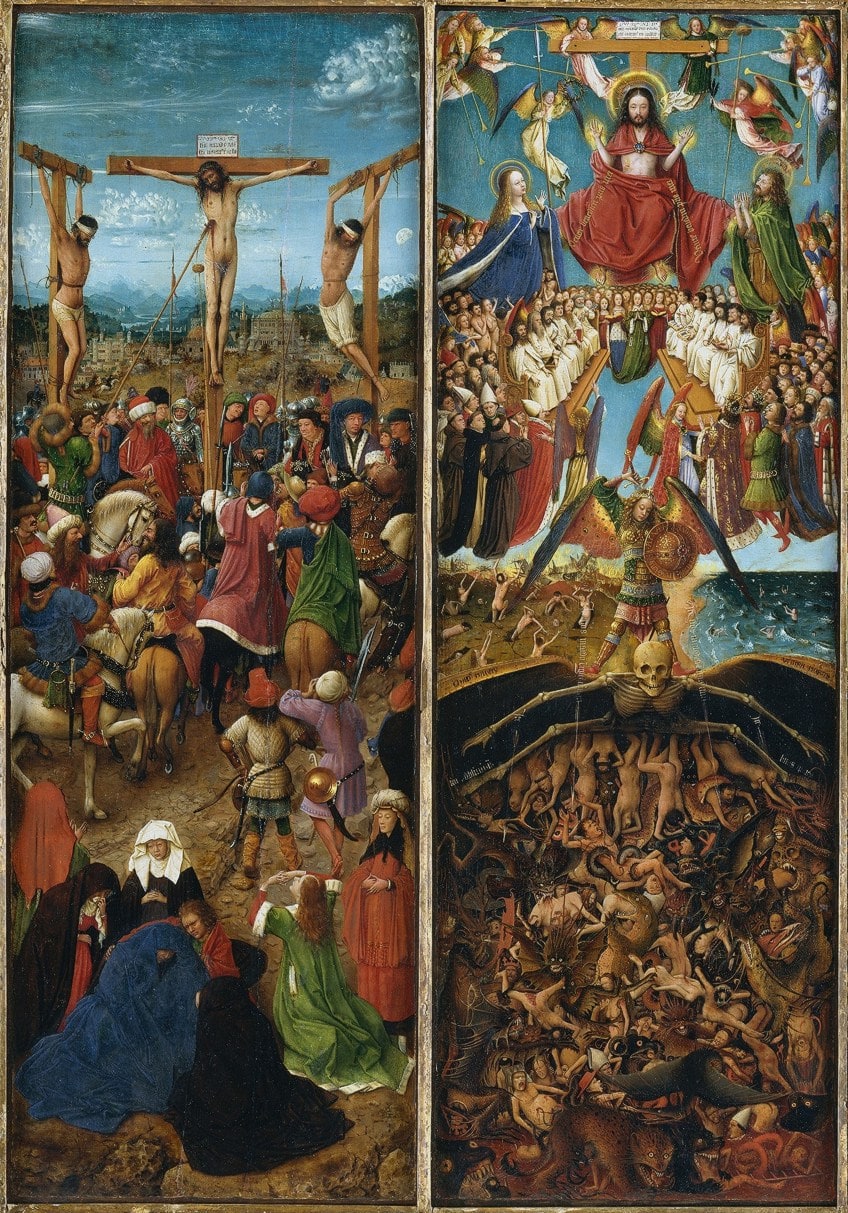
Showcasing two major biblical events side by side, The Crucifixion, as set in Jerusalem, and The Last Judgment, only strengthen the significance of the main theme of the bible itself – Jesus Christ’s sacrifice for humanity and cleansing of sin contrasted by the second coming of Christ to cast judgment on the unholy.
According to research provided by the Metropolitan Museum of Art, both panels experienced separation at some point in history, meaning the two were not always conjoined but initially served as part of a triptych or entry piece to a shrine or tabernacle.
The character of the painting thus intensifies, not only in its creation but in its journey and rediscovery.
Dante and the Three Kingdoms (1465) by Domenico Di Michelino
| Artist | Domenico Di Michelino (1417–1491) |
| Date Painted | 1465 |
| Medium | Oil on canvas |
| Dimensions (cm) | 231.9 x 289.8 |
| Where It Is housed | Museo dell’Opera del Duomo, Florence, Italy |
Also inspired by the Divine Comedy is famous Florence-born artist, Domenico di Michelino, who is most popular for his Christian paintings and renowned fresco as an homage to Dante, The Comedy Illuminating Florence (La commedia illumina Firenze), located at the Florence Cathedral.
Many Renaissance paintings of hell showcase common elements as drawn from biblical references and, of course, Dante’s vivid description of purgatory and the nine circles of hell.
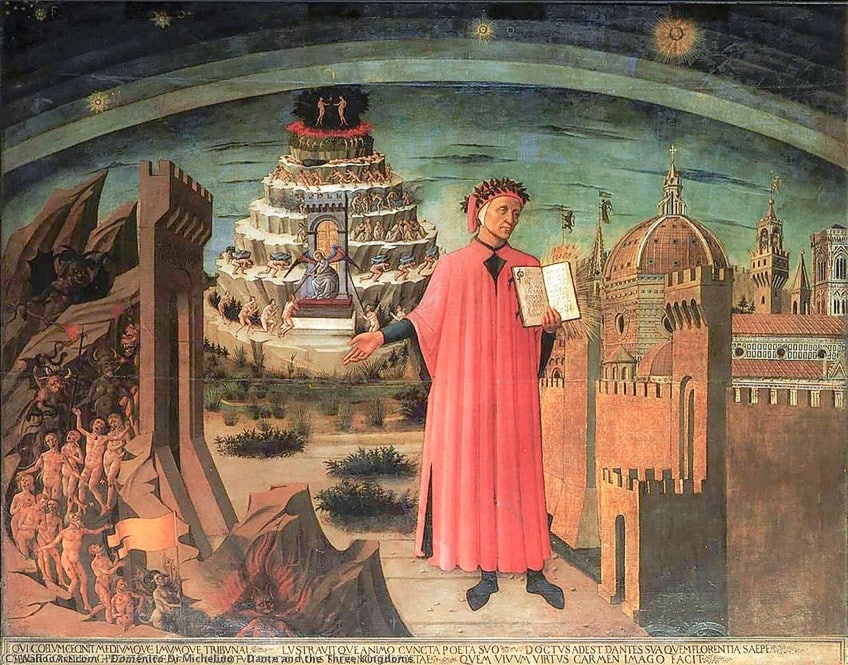
In Dante and the Three Kingdoms, Michelino illustrates his rendition of Dante’s purgatory positioned in the background and leading all the way up to the heavens. Another point worth noting is that during this time, mapping the layout of the world was very much inclusive of heavenly systems, as observed by philosophers and astronomers of the time. The artist draws attention to the sacred city of his era, Florence of 1465, under the heavenly night sky positioned to the right of purgatory, as if company for the gateway to hell.
This commissioned piece serves as a tribute to the impression that Dante’s poem had on the artists of Florence and their personal growth in developing their talents while competing for acceptance into the Salon.
Polyptych, Front Side: Earthly Vanity and Divine Salvation (1485) by Hans Memling
| Artist | Hans Memling (1430/40–1494) |
| Date Painted | 1485 |
| Medium | Oil on wood |
| Dimensions (cm) | 22 x 13.9 |
| Where It Is housed | Musée des Beaux-Arts, Strasbourg, France |
You may have heard the Latin phrase Memento Mori, meaning “remember your mortality”. Much like Hieronymus Bosch, Hans Memling draws reference to lust and vanity as defining traits that factor into the judgment of our mortality. This triptych, Earthly Vanity and Divine Salvation, doubles over as a polyptych – a fairly small portable triptych that seems to be the only of its kind known to European art of the time.
Painted over three oak panels, from the left Memling paints a corpse – not quite bones and dust, and not quite deceased either – but very much a signifier of death.
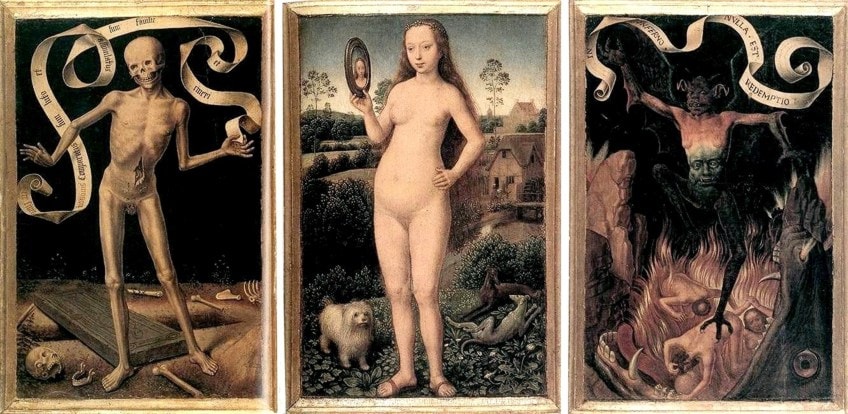
Positioned in the center is a beautifully poised nude figure of a woman gazing into her handheld mirror, lost in admiration of her reflection and beauty. A Venus with a mirror – vanity. Below her lie two hounds and a griffon. The hounds symbolize lust while the griffon draws reference to its use in many romance paintings portraying love and marriage.
Central to death is a life of vanity and lustful desires, and the true conclusion of sin is portrayed as hell – a not-so-gentle reminder of the implications of sin and a nod towards the connectedness of morality and mortality.
The Garden of Earthly Delights (1490 – 1500) by Hieronymus Bosch
| Artist | Hieronymus Bosch (1450–1516) |
| Date Painted | 1490 – 1500 |
| Medium | Oil on panel |
| Dimensions (cm) | 219.9 × 388.8 |
| Where It Is housed | Museo Nacional del Prado, Madrid, Spain |
Plunging us into complex landscapes and imaginative sprightly figures spread across three panels, famous Dutch painter Hieronymus Bosch depicted his version of what appears to be the link between pleasure and “Earthly Delights” versus the unsettling depiction of hell.
Here, Bosch presents hell through images of destruction, lust, punishment, gluttony, musical torture, war, darkness, and disgruntled faces amidst the mayhem of hell.

What makes this piece so significant is that although it presents as a simple depiction of creation and the God-given task of procreation, the painting also cleverly holds the very damnation associated with the initial task – that of lust as the primary sin and man’s overindulgence in earthly delights, which ultimately leads to hell.
Bosch is one of many famous painters of the Renaissance whose work tackled the depiction of hell and the ideology of the time.

The Last Judgement (1536 – 1541) by Michelangelo
| Artist | Michelangelo di Lodovico Buonarroti Simoni (1475–1564) |
| Date Painted | 1536–1541 |
| Medium | Fresco painting |
| Dimensions (cm) | 1369.9 x 1199.9 |
| Where It Is housed | Sistine Chapel, Vatican City, Rome, Italy |
| Price | $540M (estimated value) |
Classical. Unforgettable. Historical. In keeping with famous paintings of hell, it is useful to look toward one of the most iconic artists of the Renaissance, Michelangelo, well-known for his contributions to the Sistine Chapel. Michelangelo’s contributions to art history continue to be a source of reference for many scholars looking into Renaissance paintings of hell.
Although not a primary reference to hell, however, its association with judgment cannot be overlooked, as the journey to hell or heaven requires judgment.

The Last Judgement by Michelangelo is not only historically significant in its residency as a fresco of the famous Sistine Chapel, but it is also a religious touchstone – a carefully crafted image of the complexities of heaven, Jesus Christ (God’s son), judgment, and hell.
In a way, there cannot be one without the other, and Michelangelo knew of the weight that this painting would carry and witness.
Satan (1847) by George Frederic Watts
| Artist | George Frederic Watts (1817–1904) |
| Date Painted | 1847 |
| Medium | Oil on canvas |
| Dimensions (cm) | 197.8 x 132 |
| Where It Is housed | G. F. Watts Memorial Collection |
As much as Christ serves as the primary figure in most religious paintings, his adversary, the Devil, also features in many Renaissance hell paintings. When the Devil comes to mind, you may tend to think of a horned beast, potentially in the body of a half-human-looking figure with red scaly skin and bat-like wings. The idea of painting the devil equates to the idea of instilling fear.
This time around, the focus is not on the consequence of hell but more so on its ruler and the terrifying nature of what the devil represents.
Allowing himself to be guided by fellow masters and established artists such as Titian and Michelangelo, English painter and sculptor, George Frederic Watts delivered his rendition of hell’s master, as seen in Satan, painted as not a creature with horns, but a figure that appears to be a well-built muscular man, turning his face away from the surging waves of hellfire.
The manner in which the English painter portrays the devil begs the viewer to consider that the devil himself perhaps faces anguish and discomfort among the pits of hell. By the flames alone, you can derive that the figure engulfed in the furnace must be situated in hell and therefore the subject is Satan himself, but without the scales of protection from hellfire. He is almost in a state of vulnerability, frustration, and hopelessness, as expected of depictions of hell in art.
Aside from the fascination with the face of Satan, perhaps Watts could not imagine depicting the devil’s identity – Watts himself specialized in portraiture and had accumulated a strong track record of success in his portraits of both men and women from all angles. Food for thought?
Dante and Virgile (1850) by William-Adolphe Bouguereau
| Artist | William-Adolphe Bouguereau (1825–1905) |
| Date Painted | 1850 |
| Medium | Oil on canvas |
| Dimensions (cm) | 280.4 x 225.2 |
| Where It Is housed | Musée d’Orsay, Paris |
Returning to Dante’s poem, depicted above is Dante and Virgile as rendered by William-Adolphe Bouguereau, a French academic painter and recipient of the Prix de Rome, a scholarship for young artists of Rome. There are many artists who drew reference from The Divine Comedy, but none have done so with as much realism, depth of character, and refined use of color invested in a painting as Bouguereau has.
The painting draws reference to Dante’s eighth circle of hell, where a fight occurs between two souls sentenced to eternal damnation.

Bouguereau paints the assailant, viciously biting the neck of another – a heretic – as described in the poem. The scene seemed to have inspired Bouguereau to skillfully execute, in tremendous detail, what would be a strenuous fight to the death illustrated by distorted muscle movements, aggressive intent, agony, and desperation surrounded by hell’s mysterious onlookers.
A truly garish scene for a painter whose showstoppers involved fine brush strokes, gentle faces, and refined female figures.
Self-Portrait in Hell (1903) by Edvard Munch
| Artist | Edvard Munch (1863–1944) |
| Date Painted | 1903 |
| Medium | Oil on canvas |
| Dimensions (cm) | 82 × 66 |
| Where It Is housed | The Munch Museum, Oslo, Norway |
You may recognize this Norwegian creative by his brushstrokes and use of color. Most famously known for his painting, The Scream (1893), Edvard Munch was greatly influenced by fellow Impressionists of Europe such as Èdouard Manet and Paul Gauguin – only a few to mention of the many encounters the artist had with such revered figures.
Impressionism as one of the many movements in the historical narrative of Western art history emerged as a solution or safe haven for artists who had been rejected by the Salon due to their choice in style, subject matter, and most importantly, depiction.
While Impressionism encompassed the very first impression of real-life subject matter, Expressionism of the early 20th century allowed for more emotive elements to emerge.
For Munch, his expression of emotion as depicted in his lengthy, often flowing brushstrokes with almost child-like scratchy pastel nuances and a certain lack of detail, highlighted not so much the skill of painting for the sake of painting itself, but more so the emotion behind the scenes at the moment in which it played out.
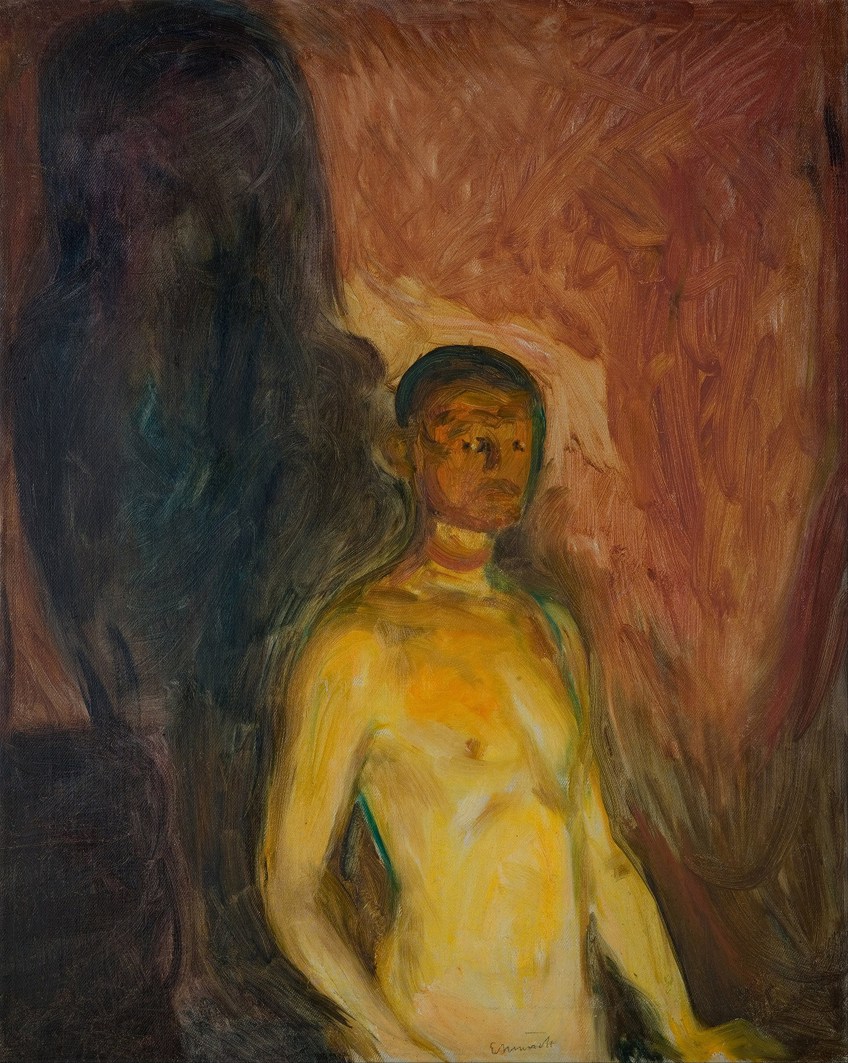
Although not a direct reference to religion-based paintings, Self-Portrait in Hell can be considered a hell artwork as it depicts the artist as imagined in hell. Since Munch’s strong affiliation with emotive painting, you can be sure to draw reference to his imagined state when painting a self-portrait captured in the depths of hell. Munch depicts himself naked, as the primary subject of the painting whose direct gaze holds that of the viewers.
The gaze is not only crucial in terms of stirring up the feeling of the viewer looking in or the artist looking out, as if in guilt – but it is the way Munch seems almost still, as if caught frozen in his own self-inflicted hell.
This is where the notion of personal hell comes in and why the turn of Impressionism and Expressionism seemed to diversify the interpretations of seemingly terrifying art. The gaze is the precipice for expansion and a mirror not only of the viewer but of a self-reflective question to the viewer. Encapsulated by the lonely background of hell, Munch also paints his flesh as if yellowed and almost with sickness in mind – perhaps the more internal physical damnation of hell as experience in his reality.
Let this not be the end of your inquisition into some of the world’s most famous hell paintings. Other like-minded, profound artists whose works match the skill and impact of Hieronymus Bosch and Edvard Munch include Pieter Bruegel, William Blake, Franz von Stuck, John Martin, and Sandro Botticelli.
Frequently Asked Questions
When Did the Renaissance Occur and What Is Its Significance?
The Renaissance (a French word) refers to a period in European history that is estimated to have commenced from the Middle Ages until the 17th century. It is commonly believed to have originated in Italy around the 14th century and is one of the most significant periods of development and radical philosophical, political, and scientific change.
What Is the Difference Between Impressionism and Expressionism?
Impressionism is a separate art movement from Expressionism. Impressionism is estimated to have appeared in Paris around 1860 as an independent movement away from the ideals of the Salon. Impressionism served to capture an environment or momentary snapshot of an object, person, group of people, or general subject in real-time, as seen through the artist’s eyes at that moment, and does not focus as much on capturing an object detail for detail as a still life would. On the other hand, Expressionism involves more emotion as projected by the artist onto the subject of the artwork. Expressionism first appeared in Germany in 1905 and incorporated elements that tended away from physical depiction and more towards emotive expression.
What Is Pictorial Illusionism?
Pictorial Illusionism can be understood in reference to visual representation via paintings, literature, visual imagery, film, theatre, or any form of media or method which enables the viewer to view an image. Illusionism in art refers to an artwork that creates an illusion of a real-world object such that it evokes a sense of the object being alive. Pictorial Illusionism falls hand in hand with cognition, the viewer’s perception of the pictorial representation, and the illusions associated with visual imagery. This can also include a trickery of the viewer’s mind when faced with a depiction of a real scene which causes the viewer to feel as though the painting were in fact alive.
Isabella studied at the University of Cape Town in South Africa and graduated with a Bachelor of Arts majoring in English Literature & Language and Psychology. Throughout her undergraduate years, she took Art History as an additional subject and absolutely loved it. Building on from her art history knowledge that began in high school, art has always been a particular area of fascination for her. From learning about artworks previously unknown to her, or sharpening her existing understanding of specific works, the ability to continue learning within this interesting sphere excites her greatly.
Her focal points of interest in art history encompass profiling specific artists and art movements, as it is these areas where she is able to really dig deep into the rich narrative of the art world. Additionally, she particularly enjoys exploring the different artistic styles of the 20th century, as well as the important impact that female artists have had on the development of art history.
Learn more about Isabella Meyer and the Art in Context Team.
Cite this Article
Isabella, Meyer, “Famous Paintings of Hell – Infernal Depictions of the Afterlife.” Art in Context. July 12, 2022. URL: https://artincontext.org/famous-paintings-of-hell/
Meyer, I. (2022, 12 July). Famous Paintings of Hell – Infernal Depictions of the Afterlife. Art in Context. https://artincontext.org/famous-paintings-of-hell/
Meyer, Isabella. “Famous Paintings of Hell – Infernal Depictions of the Afterlife.” Art in Context, July 12, 2022. https://artincontext.org/famous-paintings-of-hell/.





